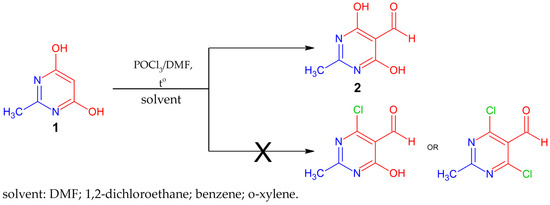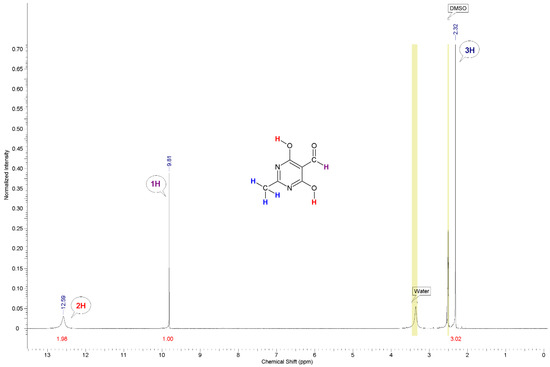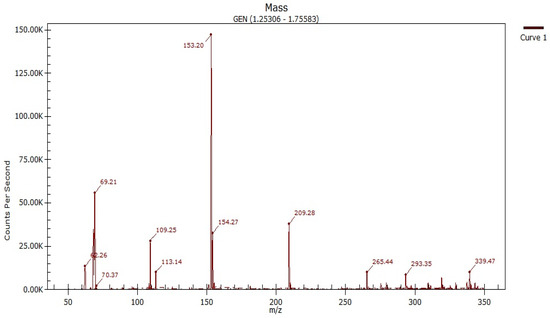Abstract
In the course of this work, we explored the influence of the conditions of the Vilsmeier–Haack reaction for 2-methylpyrimidine-4,6-diol (1). We conducted a comparative analysis of approaches using various solvents (o-xylene, N,N-dimethylformamide (DMF), benzene, and dichloroethane) as the reaction medium, and the optimal one was selected. During the formylation of substrate 1 in these conditions, only 4,6-dihydroxy-2-methylpyrimidine-5-carbaldehyde (2) was successful. It should be noted that there was no substitution of hydroxyl groups for chlorine atoms observed in reactions with similar substrates. The structure of the resulting product 2 was proven using NMR spectroscopy on 1H and 13C nuclei and by mass spectrometry.
1. Introduction
Pyrimidine hydroxy derivatives have a rather wide range of biological activities while possessing a high drug safety profile [1]. Our attention was drawn to 2-methylpyrimidine-4,6-diol (1), the 5-formyl derivative of which potentially possesses antihypertensive activity with a high probability (0.8) according to in silico screening data [2]. To perform the formylation, the Vilsmeier–Haack method was chosen as the most efficient among the known methods for the introduction of a formyl group into heterocyclic systems [3,4]. The aim of this work was to study the Vilsmeier–Haack reaction for substrate 1 and to select the optimal solvent for the reaction.
2. Materials and Methods
In silico bioactivity screening for 4,6-dihydroxy-2-methylpyrimidine-5-carbaldehyde (2) was performed using the PASS Online web resource.
The interaction of substrate 1 with Vilsmeier’s reagent in a 1:1 ratio gave 4,6-dihydroxy-2-methylpyrimidine-5-carbaldehyde (2). The substitution of hydroxyl groups for chlorine observed in reactions with similar substrates did not occur [3] (Scheme 1).

Scheme 1.
Interaction of substrate 1 with Vilsmeier’s reagent.
The synthesis was monitored by thin-layer chromatography (TLC) in a 1:9 methanol/dichloromethane system with UV detection. The structure of product 2 was proven by NMR spectroscopy at 1H (Figure 1) and 13C (Figure 2) nuclei and by mass spectrometry.

Figure 1.
1H NMR spectrum of product 2.

Figure 2.
13C NMR spectrum of product 2.
In each individual experiment, strictly equivalent amounts of substrate 1 and Vilsmeier’s reagent were taken.
2.1. Interaction of 2-Methylpyrimidine-4,6-diol with Vilsmeier’s Reagent in Benzene
The prepared and cooled mixture of phosphorus chloroxide (0.29 mL, 3.16 mmol) and DMF (0.49 mL, 6.3 mmol) under vigorous stirring was added dropwise to a suspension of 0.4 g (3.16 mmol) of substrate 1 in benzene (20 mL). The reaction was boiled with reflux condenser for 6 h. The reaction was monitored by thin-layer chromatography in a 1:9 system of methanol and dichloromethane with UV detection for the absence of the starting compound in the reaction mixture. The reaction mixture was poured on ice and stirred overnight. The resulting precipitate was filtered off then dried at 60 °C. The practical yield of product 2 was 48%.
The NMR spectrum (1H, DMSO-d6) of the synthesised compound 2 is characterised by the presence of an aldehyde group proton singlet at 9.81 ppm with an integrated intensity of 1. There is also an OH-group proton singlet at 12.59 ppm with an integrated intensity of 1.96 and a methyl group proton singlet at 2.32 ppm with an integrated intensity of 3.02.
The NMR spectrum (13C, DMSO-d6) of the synthesised compound 2 is characterised by signals of methyl group carbon atoms (C1) in the region of 18.39 ppm, a C2 atom in the region of 99.7 ppm, C3 in the region of 161.92 ppm, C4 and C5 carbon atoms at −163.57 ppm, and a carbon atom of carbonyl group (C6) in the region of 185.87 ppm.
MS-ESI mass spectrometry: m/z [M-H]—calculated: 153.33; found: 153.20.
2.2. Interaction of 2-Methylpyrimidine-4,6-diol with Vilsmeier’s Reagent in 1,2-Dichloroethane
A previously prepared and cooled mixture of phosphorus chloroxide (0.29 mL, 3.16 mmol) and DMF (0.49 mL, 6.3 mmol) was added carefully dropwise to a suspension of 0.4 g (3.16 mmol) of substrate 1 in 1,2-dichloroethane (20 mL) under vigorous stirring. The reaction was boiled with reverse refrigerator for 6 h. The reaction was monitored by thin-layer chromatography in a 1:9 methanol/dichloromethane system with UV detection for the absence of the starting compound in the reaction mixture. The reaction mixture was poured on ice and stirred overnight. The resulting precipitate was filtered and dried at 60 °C. The practical yield of product 2 was 50%.
The NMR spectrum (1H, DMSO-d6) of the synthesised compound 2 is characterised by the presence of an aldehyde group proton singlet at 9.79 ppm with an integrated intensity of 1.01; there is also an OH-group proton singlet at 12.53 ppm with an integrated intensity of 2.04 and a methyl group proton singlet at 2.41 ppm with an integrated intensity of 2.96.
The NMR spectrum (13C, DMSO-d6) of the synthesised compound 2 is characterised by signals of methyl group carbon atoms (C1) in the region of 18.21 ppm, a C2 atom in the region of 99.56 ppm, C3 in the region of 161.13 ppm, C4 and C5 carbon atoms at −163.69 ppm, and a carbon atom of carbonyl group (C6) in the region of 185.55 ppm.
MS-ESI mass spectrometry: m/z [M-H]—calculated: 153.33; found: 153.11.
2.3. Interaction of 2-Methylpyrimidine-4,6-diol with Vilsmeier’s Reagent in DMF
The prepared and cooled mixture of phosphorus chloroxide (0.29 mL, 3.16 mmol) and DMF (0.49 mL, 6.3 mmol) was carefully added dropwise to a suspension of 0.4 g (3.16 mmol) of substrate 1 in DMF (3 mL) under vigorous stirring. The reaction was incubated at 80 °C for 5 h. The reaction was monitored by thin-layer chromatography in a 1:9 methanol/dichloromethane system with UV detection for the absence of the starting compound in the reaction mixture. The reaction mixture was poured on ice and stirred overnight. The resulting precipitate was filtered off and dried at 60 °C. The practical yield of product 2 was 61%.
The NMR spectrum (1H, DMSO-d6) of the synthesised compound 2 is characterised by the presence of an aldehyde group proton singlet in the region of 9.8 ppm with an integrated intensity of 0.96; there is also an OH-group proton singlet in the region of 12.6 ppm with an integrated intensity of 2.20 and a methyl group proton singlet in the region of 2.31 ppm with an integrated intensity of 2.94.
The NMR spectrum (13C, DMSO-d6) of the synthesised compound 2 is characterised by signals of methyl group carbon atoms (C1) in the region of 18.91 ppm, a C2 atom in the region of 99.34 ppm, C3 in the region of 161.35 ppm, C4 and C5 carbon atoms at −163.54 ppm, and a carbon atom of carbonyl group (C6) in the region of 185.76 ppm.
MS-ESI mass spectrometry: m/z [M-H]—calculated: 153.33; found: 153.47.
2.4. Interaction of 2-Methylpyrimidine-4,6-diol with Vilsmeier’s Reagent in o-Xylene
The prepared and cooled mixture of phosphorus chloroxide (0.29 mL, 3.16 mmol) and DMFA (0.49 mL, 6.3 mmol) was added dropwise to a suspension of 0.4 g (3.16 mmol) of substrate 1 in o-xylene (20 mL) under vigorous stirring. The reaction was incubated at 100 °C for 7. The reaction was monitored by thin-layer chromatography in a 1:9 methanol/dichloromethane system with UV detection for the absence of the starting compound in the reaction mixture. The reaction mixture was poured on ice and stirred overnight. The resulting precipitate was filtered off and dried at 60 °C. The practical yield of product 2 was 49%.
The NMR spectrum (1H, DMSO-d6) of the synthesised compound 2 is characterised by the presence of an aldehyde group proton singlet in the region of 9.91 ppm with an integrated intensity of 0.94; there is also an OH-group proton singlet in the region of 12.58 ppm with an integrated intensity of 1.89 and a methyl group proton singlet in the region of 2.54 ppm with an integrated intensity of 3.13.
The NMR spectrum (13C, DMSO-d6) of the synthesised compound 2 is characterised by signals of methyl group carbon atoms (C1) in the region of 18.23 ppm, a C2 atom in the region of 99.44 ppm, C3 in the region of 161.33 ppm, C4 and C5 carbon atoms −163.78 ppm, and a carbon atom of carbonyl group (C6) in the region of 185.45 ppm.
MS-ESI mass spectrometry: m/z [M-H]—calculated: 153.33; found: 153.01.
3. Results and Discussion
Based on the PASS Online screening data, product 2 has a probability (probably active) greater than 0.8 of being an agonist of I1-imidazoline receptors, which accounts for its antihypertensive activity.
I1-imidazoline receptors are responsible for the antihypertensive activity.
Regardless of the solvent used, the reaction of substrate 1 with Vilsmeier’s reagent in a 1:1 ratio resulted in the formation of product 2, which was confirmed by NMR spectroscopy data at 1H (Figure 1) and 13C nuclei (Figure 2), as well as by mass spectrometry (Figure 3).

Figure 3.
Mass spectrum of product 2 (ESI in negative-ion mode).
As a result of this work, the optimal solvent for the above reaction was selected. In DMF medium, product 2 was obtained with the highest practical yield of 61% at a holding time of 5 h (Table 1).

Table 1.
Dependence of reaction parameters on the solvent used.
4. Conclusions
The reaction of 2-methylpyrimidine-4,6-diol with Vilsmeier’s reagent at their equivalent ratio leads to the formation of only 4,6-dihydroxy-2-methylpyrimidine-5-carbaldehyde. The substitution of hydroxyl groups observed on similar substrates to the chlorine atom did not occur.
The use of DMF as a solvent in the formation of substrate 1 leads to a higher practical yield of product 2 and a shorter residence time compared to benzene, 1,2-dichloroethane, and o-xylene.
Author Contributions
Conceptualization, I.P.Y. and D.A.K.; methodology, A.V.D.; software, A.V.D.; validation, D.A.K.; formal analysis, A.V.D.; investigation, A.V.D.; resources, A.V.D.; data curation, D.A.K.; writing—original draft preparation, A.V.D.; writing—review and editing, T.L.S.; visualization, T.L.S.; supervision, I.P.Y.; project administration, I.P.Y. All authors have read and agreed to the published version of the manuscript.
Funding
This research received no external funding.
Institutional Review Board Statement
Not applicable.
Informed Consent Statement
Not applicable.
Data Availability Statement
The data presented in this study are available upon request from the corresponding author.
Conflicts of Interest
The authors declare no conflicts of interest.
References
- Samotrueva, M.A.; Tsibizova, A.A.; Yasenyavskaya, A.L.; Ozerov, A.A.; Tyurenkov, I.N. Farmakologicheskaia aktivnost’ proizvodnykh pirimidinov. Astrakhanskii Meditsinskii Zhurnal 2015, 10, 12–29. (In Russian) [Google Scholar]
- PASS Online. Available online: https://www.way2drug.com/PassOnline/predict.php (accessed on 12 November 2023).
- Rajput, A.P.; Girase, P.D. Review article on Vilsmeier—Haackreaction. Int. J. Pharmac. Chem. Biolog. Sci. 2012, 3, 25–43. [Google Scholar]
- Ofitserova, E.S.; Shklyarenko, A.A.; Yakovlev, I.P.; Fedorova, E.V. Formilirovanie 2-(metiltio)pirimidin-4,6-diola v usloviiakh reaktsii Vil’smeiera-KHaaka (kratkoe soobshchenie). Razrab. I Regist. Lek. Sredstv 2017, 112–114. (In Russian) [Google Scholar]
Disclaimer/Publisher’s Note: The statements, opinions and data contained in all publications are solely those of the individual author(s) and contributor(s) and not of MDPI and/or the editor(s). MDPI and/or the editor(s) disclaim responsibility for any injury to people or property resulting from any ideas, methods, instructions or products referred to in the content. |
© 2024 by the authors. Licensee MDPI, Basel, Switzerland. This article is an open access article distributed under the terms and conditions of the Creative Commons Attribution (CC BY) license (https://creativecommons.org/licenses/by/4.0/).